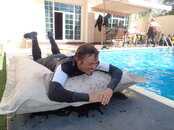By skin gear gear I mean mask, snorkel, fins, wetsuit, weights.
@Jim Lapenta mentioned teaching buoyancy and trim that way, swimming in neutral trim, and diving down for a moment and settling for a few seconds, before going to scuba. We do some mask drills in skin gear before scuba, but the trim, when stationary to do the drill, is usually rather vertical, due to the weight belt being low, or there is a lot of kicking to hold trim. My personal experience is you can tune skin buoyancy exactly, for example for ditch and recover/don of mask/snorkel/fins on bottom, but non-swimming trim is very hard with just a weight belt.
@NorCalDM we train in Monterey but we do our skills checkouts at Del Monte beach, which is typically calm water. But it is also a very boring beach with sand and a bit of sea grass. The downside of Del Monte is divers think they have seen Nor Cal diving, but all they’ve seen so far is a cold underwater sand lot with some grass. That may influence why people use Breakwater for checkout dives. This last class we did checkouts mid water, but we had an instructor and 1 or 2 DM/TAs per dive team and students come to us as OW or AOW already. In low vis we've cycled student teams through being down with the instructor to do the checkout drills. We do a day of checkouts + Nav, then Nav, then a day of rescues at that beach. For later dives we are often at Breakwater, and see the large groups wading into the surf to do drills. Edit:

. The only other groups we've seen using Del Monte are other universities.





